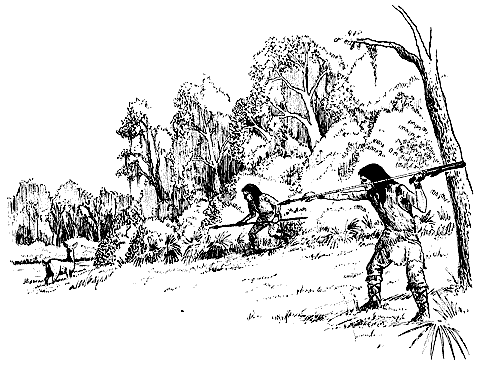Yat Kitischee – Prehistoric Timeline
Paleo-Indian Period
Fourteen thousand years ago, near the end of the last ice-age, Florida was nearly twice as large as it is today because much of the world’s sea water was trapped in massive glaciers. The resulting lower sea levels exposed a much greater land mass. Florida’s climate was also cooler and drier than today. Vast, open savannah supported large, grazing animals like mastodon and bison. Florida’s first human inhabitants, known by archaeologists as Paleo-Indians, hunted these large mammals. Paleo-Indian sites are identified by distinctive lanceolate-shaped spear points that are found throughout the Tampa Bay area, particularly around sinkhole springs which were the primary source of water for humans and animals.
Archaic Period
As the climate warmed, the large glaciers melted and sea levels began to rise. The large Ice Age mammals became extinct and people began to hunt modern animals like deer, raccoon, opossum, and squirrel. They also collected plants and fished. Larger populations coupled with a reduced land mass resulted in the exploration and settlement of many new environments. Some Archaic populations retained a mobile lifestyle while others became relatively sedentary. The first pottery was introduced during the late Archaic period (ca. 2000 B.C.).
Weedon Island

The Weedon Island site is a large shell midden and burial mound complex located on the west shore of Tampa Bay about five miles southeast of Yat Kitischee. The site first gained national attention in the early 1920s when J. Walter Fewkes of the Smithsonian Institution excavated a portion of the burial mound. These excavations discovered the finely made and ornately decorated mortuary vessels that archaeologists have come to associate with the Weedon Island culture. The site was again investigated in the 1960s by William Sears of the Florida State Museum. Sears excavated a small area of the shell midden near the burial mound. But instead of decorated pottery, Sears found many sherds of plain, utilitarian pottery in the midden. The presence of different pottery types in mortuary and domestic contexts was a pattern that Sears had noticed at other sites on Florida’s central Gulf Coast. Recent research by Jerald Milanich in north-central Florida, and George Luer and Marion Almy on the central Gulf coast, has demonstrated that the Weedon Island culture was actually centered in north Florida and southern Georgia and Alabama, and that the people who lived at Weedon Island were actually members of the Manasota culture.
Safety Harbor
The Safety Harbor site is located at Phillipi Park near the town of Safety Harbor about 15 miles due north of Yat Kitischee. Excavations were first conducted there in 1930 by Mathew Stirling of the Smithsonian Institution. The site contains a large, flat-topped, temple mound, several burial mounds, and a large village area with associated middens. Stirling concentrated on the burial mound, but later work by John Griffin and Ripley Bullen of the Florida Park Service focused on the temple mound and the village area. Recovery of Spanish artifacts dateable to the 16th century have led archaeologists to conclude that Safety Harbor is the town of Tocobaga visited by the Spanish explorer Pedro Menendez de Aviles in 1567. Menendez established a garrison at the village, and left 30 soldiers and a captain there. When the Jesuit priest Juan Rogel visited the site later that year, he reported nothing amiss. However, when he returned to Tocabaga in January of 1568, Rogel found the village deserted and all of the Spaniards dead.
Seminoles and Miccosukees
The native peoples of Florida were decimated by disease, warfare, and social disintegration brought about by contact with the Spanish. This left much of Florida uninhabited by the early 18th century. Creek Indians from Georgia and Alabama moved into Florida and eventually became known as the Seminoles.